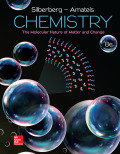
(a)
Interpretation:
The correct formula for
Concept introduction:
The general rules for writing the systematic names of ionic compounds are as follows:
1) In binary ionic compounds, the name of the metal is written as the original name whereas the name of the non-metal has the root word with the suffix
2) In metals that form more than one ion, the Latin root of the metal is followed by a suffix
3) In the family of two oxoanions, the ion with more oxygen atoms has the non-metal root and a suffix
4) For hydrated ionic compounds, the total number of water molecules are represented by the Greek numerical prefixes followed by the word hydrate.
(a)
Answer to Problem 2.10BFP
The correct formula for the compound
Explanation of Solution
Copper is a
The correct formula for the compound
(b)
Interpretation:
The correct name for the compound
Concept introduction:
The general rules for writing the systematic names of ionic compounds are as follows:
1) In binary ionic compounds, the name of the metal is written as the original name whereas the name of the non-metal has the root word with the suffix
2) In metals that form more than one ion, the Latin root of the metal is followed by a suffix
3) In the family of two oxoanions, the ion with more oxygen atoms has the non-metal root and a suffix
4) For hydrated ionic compounds, the total number of water molecules are represented by the Greek numerical prefixes followed by the word hydrate.
(b)
Answer to Problem 2.10BFP
The correct name for the compound
Explanation of Solution
The element lead forms more than one ion
The correct name for the compound
(c)
Interpretation:
The correct formula for the compound chromic sulfide is to be determined.
Concept introduction:
The general rules for writing the systematic names of ionic compounds are as follows:
1) In binary ionic compounds, the name of the metal is written as the original name whereas the name of the non-metal has the root word with the suffix
2) In metals that form more than one ion, the Latin root of the metal is followed by a suffix
3) In the family of two oxoanions, the ion with more oxygen atoms has the non-metal root and a suffix
4) For hydrated ionic compounds, the total number of water molecules are represented by the Greek numerical prefixes followed by the word hydrate.
(c)
Answer to Problem 2.10BFP
The correct formula for the compound chromic sulfide is
Explanation of Solution
The chromic ion is represented by the formula
The chromic and sulfide ions combine in the
The correct formula for the compound chromic sulfide is
(d)
Interpretation:
The systematic name for
Concept introduction:
The general rules for writing the systematic names of ionic compounds are as follows:
1) In binary ionic compounds, the name of the metal is written as the original name whereas the name of the non-metal has the root word with the suffix
2) In metals that form more than one ion, the Latin root of the metal is followed by a suffix
3) In the family of two oxoanions, the ion with more oxygen atoms has the non-metal root and a suffix
4) For hydrated ionic compounds, the total number of water molecules are represented by the Greek numerical prefixes followed by the word hydrate.
(d)
Answer to Problem 2.10BFP
The systematic name for
Explanation of Solution
The element oxygen is a non-metal from the
The element iron forms more than one ion
Therefore, the charge on the ferrous ion is mentioned as Roman numerals within the parentheses next to the metal name in the systematic name.
The systematic name for
Want to see more full solutions like this?
Chapter 2 Solutions
EBK CHEMISTRY: THE MOLECULAR NATURE OF
 ChemistryChemistryISBN:9781305957404Author:Steven S. Zumdahl, Susan A. Zumdahl, Donald J. DeCostePublisher:Cengage Learning
ChemistryChemistryISBN:9781305957404Author:Steven S. Zumdahl, Susan A. Zumdahl, Donald J. DeCostePublisher:Cengage Learning ChemistryChemistryISBN:9781259911156Author:Raymond Chang Dr., Jason Overby ProfessorPublisher:McGraw-Hill Education
ChemistryChemistryISBN:9781259911156Author:Raymond Chang Dr., Jason Overby ProfessorPublisher:McGraw-Hill Education Principles of Instrumental AnalysisChemistryISBN:9781305577213Author:Douglas A. Skoog, F. James Holler, Stanley R. CrouchPublisher:Cengage Learning
Principles of Instrumental AnalysisChemistryISBN:9781305577213Author:Douglas A. Skoog, F. James Holler, Stanley R. CrouchPublisher:Cengage Learning Organic ChemistryChemistryISBN:9780078021558Author:Janice Gorzynski Smith Dr.Publisher:McGraw-Hill Education
Organic ChemistryChemistryISBN:9780078021558Author:Janice Gorzynski Smith Dr.Publisher:McGraw-Hill Education Chemistry: Principles and ReactionsChemistryISBN:9781305079373Author:William L. Masterton, Cecile N. HurleyPublisher:Cengage Learning
Chemistry: Principles and ReactionsChemistryISBN:9781305079373Author:William L. Masterton, Cecile N. HurleyPublisher:Cengage Learning Elementary Principles of Chemical Processes, Bind...ChemistryISBN:9781118431221Author:Richard M. Felder, Ronald W. Rousseau, Lisa G. BullardPublisher:WILEY
Elementary Principles of Chemical Processes, Bind...ChemistryISBN:9781118431221Author:Richard M. Felder, Ronald W. Rousseau, Lisa G. BullardPublisher:WILEY





